
* The McDonnell "F-101 Voodoo" was one of the US Air Force's first operational supersonic fighters. It served as a tactical nuclear strike aircraft, an interceptor, and in particular as a photo-reconnaissance platform, with considerable combat experience in the reconnaissance role during the Vietnam War. This document gives a history and description of the Voodoo. A list of illustration credits is provided at the end.
* In the postwar period, US Army Air Forces (USAAF) brass knew that jet engines were the way of the future for fighter aircraft, but the service was confronted with the difficulty that their first generation of jet fighter aircraft had limited range, preventing them from being used on penetration or escort missions. In early 1946, the USAAF issued a requirement for a long-range jet fighter to fill this gap.
Three companies were selected in June 1946 to build prototypes for evaluation. North American submitted the "YP-93A", derived from their F-86 Sabre but featured a new "fat" fuselage; Lockheed submitted the "XP-90", which was something like a P-80 Shooting Star, rethought with swept flight surfaces and streamlining; and McDonnell submitted their "XP-88". McDonnell hadn't built a production fighter for the USAAF before, but the company had designed and was building the FH-1 Phantom jet fighter for the US Navy.
The XP-88 was designed by a team under Edward M. "Bud" Flesh. It was, at least in hindsight, the most promising of the three designs, with a tidy streamlined fuselage, low-mounted wings with a sweepback of 35 degrees and a swept tail of conventional arrangement -- a vee tail was considered, but not implemented. The XP-88 was powered twin Westinghouse J34-WE-13 turbojets with 13 kN (1,360 kgp / 3,000 lbf) thrust each, with engine intakes in the wingroots. Armament was to be six 20-millimeter cannon.
In 1947, the USAAF became the US Air Force (USAF); the year after that, the service changed the "P" for "pursuit" code to "F" for "fighter", with the XP-88 becoming the "XF-88". Initial flight of the first of two XF-88 prototypes was on 20 October 1948, with company test pilot Robert Eldholm at the controls. Performance was disappointing, mostly because the Westinghouse engines lacked thrust. Westinghouse had been one of the pioneers of jet propulsion in the US, but the company was falling badly behind the competition, and Westinghouse would get out of the business in a few years' time.
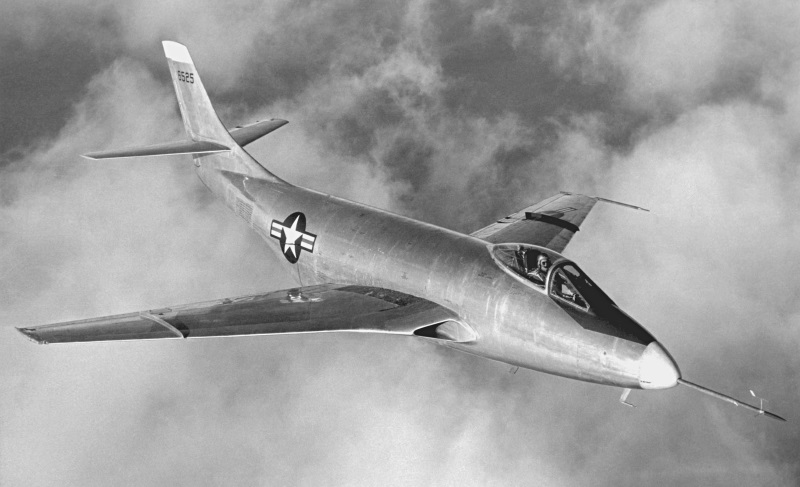
The second XF-88 was refitted with afterburning J34-WE-22 engines providing an afterburning thrust of 16.0 kN (1,635 kgp / 3,600 lbf), with the updated aircraft given the new designation of "XF-88A". However, by that time the program was faltering due to funding and requirements changes, and none of the three contenders entered production. The production "F-88" aircraft was to have been powered by afterburning Westinghouse J46 turbojets. McDonnell came up with "paper plans" for a carrier version of the XF-88, as well as two-seat and reconnaissance versions, but of course they didn't happen.
___________________________________________________________________
MCDONNELL XF-88A:
___________________________________________________________________
wingspan:
12.09 meters (39 feet 8 inches)
wing area:
32.52 sq_meters (350 sq_feet)
length:
16.51 meters (54 feet 2 inches)
height:
5.26 meters (17 feet 3 inches)
empty weight:
5,505 kilograms (12,140 pounds)
MTO weight:
8,390 kilograms (18,500 pounds)
max speed at altitude:
1,135 KPH (705 MPH / 615 KT)
service ceiling:
12,000 meters (39,400 feet)
range:
2,795 kilometers (1,735 MI / 1,510 NMI)
___________________________________________________________________
The original XF-88 prototype was also updated to XF-88A configuration, being further updated in 1949 as a trials aircraft with an Allison XT38A turboprop engine with 1,875 kW (2,500 SHP) in the nose, retaining its J34 turbojets as well. It was redesignated "XF-88B" and performed its first flight in this configuration on 14 April 1953. Since some fuel tankage had to be removed to accommodate the turboprop engine, the three engines guaranteed that flight endurance was notably short.
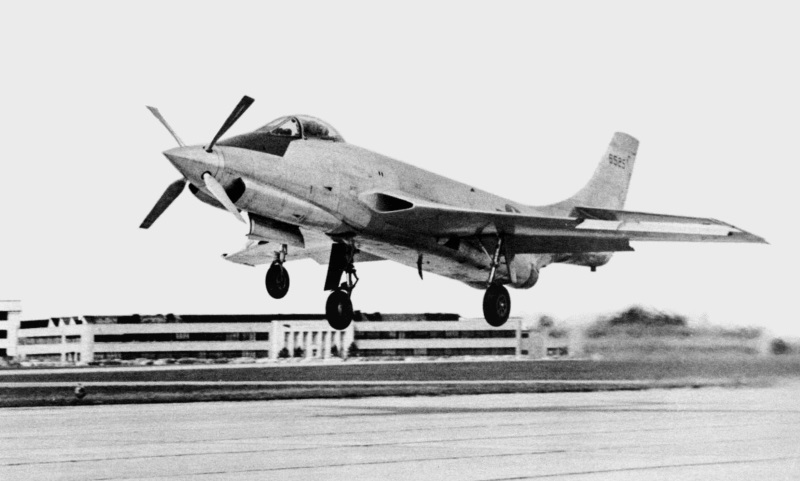
The XF-88B was used by the USAF and the US National Advisory Committee on Aeronautics (NACA, the predecessor to the modern National Aeronautics & Space Agency / NASA) to evaluate high-performance propellers, with the trials continuing into 1956. Although there was considerable interest in high-speed turboprop propulsion at the time, to no surprise it was a dead end -- one of the reasons being that high-speed props were unbelievably noisy, even making ground crews ill. Both the XF-88A and the XF-88B were eventually scrapped.
BACK_TO_TOP* Although the XF-88 program had been a nonstarter in itself, the Air Force thought the design had potential. In early 1951, the service requested a more capable derivative that could be used as a long-range escort fighter under "Weapons System 105A (WS-105A)". Bud Flesh's team went back to the drawing board and came up with what amounted to a bigger and badder version of the XF-88. Lockheed, North American, Northrop, and Republic also submitted proposals; in May 1951 the McDonnell submission was accepted, being designated the "F-101 Voodoo".
The XF-88A was used as a trials platform to evaluate elements of the new aircraft, and the first "F-101A" -- there were no formal prototypes or evaluation machines -- performed its first flight on 29 September 1954 at Edwards AFB. Robert C. Little was at the controls, with the machine breaking Mach 1 on this initial flight.
The Air Force dropped the long-range fighter requirement, and so the F-101A was produced as a tactical nuclear strike fighter. Its lines were roughly similar to those of the XF-88, but the empty weight of the new machine was twice as great; it was, in fact, one of the biggest single-seat fighters built to that time. It had a tee tail arrangement with an "all-moving" tailplane, and significantly replaced the two inadequate Westinghouse J34 engines with two much more formidable Pratt & Whitney J57-P-13 turbojets, providing 52.1 kN (5,310 kgp / 11,700 lbf) thrust each. The engines were fed by inlets in the wingroots, with splitter plates next to the fuselage to prevent them from ingesting stagnant "boundary layer" air hugging the skin of the aircraft.
Two external tanks with a capacity of 1,705 liters (450 US gallons) could be carried in parallel under the fuselage, a feature common to all Voodoo variants. Sources claim that there was a pop-up refueling probe in the nose, as well as at least provisions for a boom refueling receptacle in the spine. The nose probe seems likely because all other production variants of the Voodoo had it as well, but sources are mixed on whether any Voodoos ever actually had a refueling receptacle.

Armament consisted of four Colt M39 20-millimeter revolver-type cannon and a centerline external nuclear store. Offensive avionics were built around the MA-7 fire control system (FCS) featuring AN/APS-54 radar and the MA-2 "Low Altitude Bombing System (LABS)". The MA-2 LABS was an analog computer that provided support for "toss bombing", in which the munition was to be released in a climb, to fall back down to the target while the launch aircraft arced back over to exit the area as fast as possible. The F-101A was strictly a nuclear weapon delivery system, with no real conventional attack capability except for its cannon. In service, one of the cannon was generally removed to allow installation of a TACAN navigation radio beacon receiver.
The F-101A featured tricycle landing gear, all with single wheels, the main gear retracting inward from the wings towards the fuselage and the nosewheel retracting forward -- incidentally, if a pilot put on too much airspeed too soon at take-off, the nosewheel wouldn't retract. There was a hydraulically-actuated airbrake on each side of the fuselage behind the wing, and a brake parachute in the tail. The pilot sat on an ejection seat under a clamshell canopy that hinged on the rear.
* Initial delivery to the USAF was in May 1957, with the service acquiring a total of 77 F-101As. They were mostly deployed to Europe. It appears that the F-101A was not particularly liked; it was a speedy, sleek machine, but it had its share of teething problems. In particular, it had an unpleasant tendency to "pitch up" with little provocation at high speed, resulting in deadly accidents. Some modifications to the flight control system would lessen the severity of the problem, but it would never be completely eliminated -- it was inherent in the small swept wing and the tee tail configuration -- and all Voodoos suffered from it.
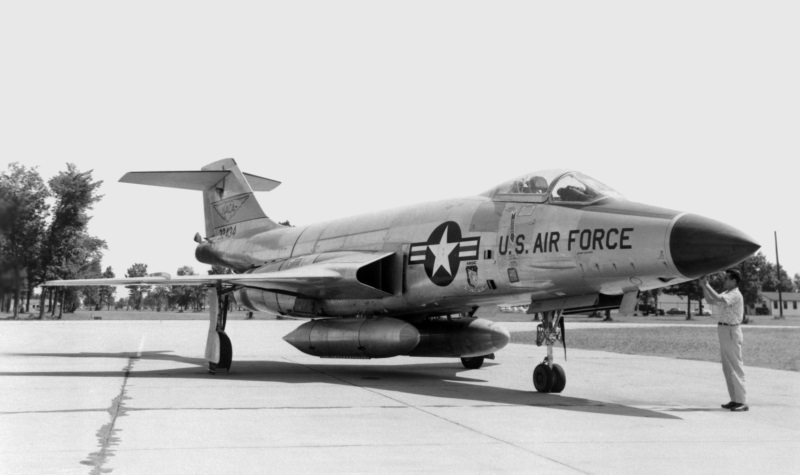
The F-101A was followed by the externally identical "F-101C", with 47 built, the only significant change being that the F-101C had a strengthened airframe and a slightly greater empty weight. F-101A/Cs in service generally flew in natural metal finish. The F-101A/C served into the mid-1960s, when it was replaced in the tactical nuclear strike role by the F-4 Phantom, another McDonnell fighter and with design influence from the Voodoo. Most of the F-101A/Cs were then converted to a reconnaissance configuration, as discussed below. Two were used for engine trials, with the "JF-101A" trials machine discussed below and the "NF-101A" being used to test the General Electric J79 turbojet, apparently for a J79-powered "F-101D/E" variant that never materialized. Two others were obtained by NASA for trials as well.
BACK_TO_TOP* The F-101A had been originally conceived as a long-range escort fighter, but ended up being a fighter-bomber. While it was in the works, the Air Force also decided the service needed a new two-seat all-weather interceptor. At the time, the standard interceptor was the Northrop F-89 Scorpion, more or less a first-generation jet fighter; the Air Force had been working with Convair on the F-102A Delta Dagger as a supersonic replacement, with this machine being a stepping-stone to the much improved F-102B, which would eventually emerge as the superlative F-106 Delta Dart. However, getting the F-102A to fly right proved troublesome, placing the F-102B farther out in the future than Air Force brass liked -- so in late 1953, a request for proposals was issued under "Weapons System 217A (WS-217A)" for a two-seat supersonic interceptor to plug the gap.
Northrop offered a swept-wing version of the Scorpion, North American offered a variant of the F-100 Super Sabre, and McDonnell offered a variant of the F-101. In June 1954, the Air Force selected the McDonnell offering, which emerged as the "F-101B", with initial flight of the "NF-101B" prototype on 27 March 1957, and initial deliveries to the USAF in March 1959.
The major change with the F-101B versus the F-101A was a new forward fuselage, with tandem seats for the pilot (in front) and weapon systems operator (in back) under a single clamshell canopy that hinged up from the rear. The F-101B was fitted with uprated J57-P-55 turbojets providing 53.4 kN (5,440 kgp / 11,990 lbf) thrust each, with the engines featuring distinctive longer afterburners with a cooling vent on the underside. The J57-P-55 was trialed in an F-101A that was redesignated "JF-101A", noted above, which set a world speed record of 1,943 KPH (1,207 MPH) in late 1957. The NF-101B prototype, incidentally, used the J57-P-13 engines used on all other Voodoo production variants.

Cannon armament was deleted, primary armament being four Falcon air-to-air missiles (AAMs) in a weapons bay, usually a mix of GAR-1 semi-active radar homing (SARH) AAMs and GAR-2 infrared heat-seeking AAMs -- procedure was usually to launch a SARH and a heat-seeking Falcon together in hopes that if one didn't work, the other would. The specific history of the Falcon series involved a complicated series of GAR designations, which was simplified when they all became variants of the "AIM-4" during the Pentagon's change of designation system in 1962. The weapons bay door carried two missiles in recesses on each side, flipping over after the first pair were fired. Some sources indicate the F-101A/C actually could carry AAM armament as well, but if it was ever planned, it wasn't implemented.
Late production F-101Bs were capable of carrying two MB-1 Genie AAMs in place of two Falcons. The Genie was an unguided weapon with a small nuclear warhead, detonated by a timer set by the FCS. It was mainly intended to support "collision-course" intercepts, in which the Voodoo approached the target from its forward sector. That meant a very fast relative closing speed and a very narrow time window to obtain a "kill" on the target: given the relative lack of refinement of AAM guidance systems at the time, a nuke was felt to be the best tool for the job. The Genies were "draggy", and so the two Falcons were normally carried on the external side of the door. The armament was directed by a Hughes MG-13 fire control system, a derivative of the E-6 used on the F-89. The greater weight of the F-101B led to the fit of fatter tires that required bulged gear doors.
A total of 479 F-101Bs was built into 1961, not counting the NF-101B prototype. Of this total, 79 were built with dual controls for operational conversion and were originally designated "TF-101B"; 152 F-101Bs were later upgraded to dual controls as well, with the designation migrating to "TF-101F" and finally "F-101F". The trainers were externally all but identical to F-101Bs, were fully combat-capable, and were sometimes used in an operational capacity. The F-101B/F originally flew in natural metal finish but soon acquired a natty coat of overall light gray, mostly for corrosion protection.
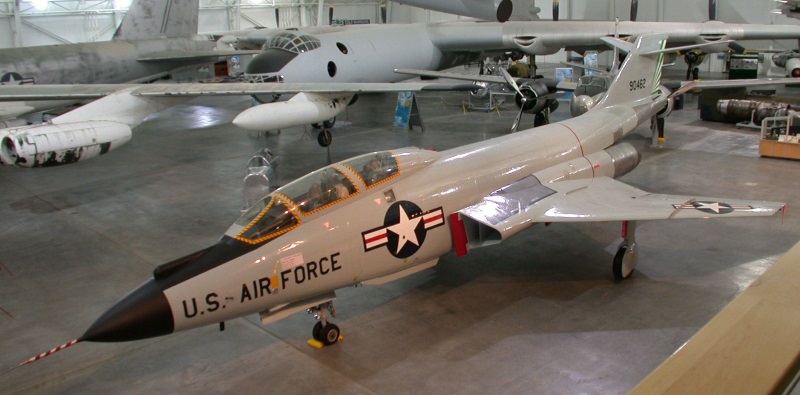
From 1963 into 1966, the F-101B fleet was given a fairly comprehensive upgrade under the BOLD JOURNEY program. The primary changes were to improve the FCS and to add an infrared search & track (IRST) sensor on the nose, in place of the inflight refueling probe. The F-101B remained in first-line USAF service through the 1960s, to then be generally phased out to the Air National Guard (ANG) in 1971. The F-101B was finally withdrawn from service in 1982.
Two F-101Bs were used for trials and redesignated "JF-101B"; another was more extensively modified and redesignated "NF-101B". The F-101B remained in service with the USAF Air Defense Command (ADC) into the early 1980s. At least one F-101B was flown in private hands, by Colorado State University, for thunderstorm research.
* The only major foreign operator of the Voodoo was the Royal Canadian Air Force (RCAF). After the cancellation of the Avro Canada CF-105 Arrow interceptor in 1959, the Royal Canadian Air Force (RCAF) needed to obtain a high-speed interceptor to replace the sturdy but elderly Avro Canada CF-100 "Canuck"; after discussions with the USA, the Canadians decided to adopt the F-101B.
A total of 56 F-101Bs and 10 F-101Fs was supplied under Operation QUEENS ROW in 1961 and 1962. They were all ex-USAF machines, but they were "like new", only a few years old. They were armed with twin Falcon and twin Genie missiles, with the nuclear-armed Genies operated under a dual-key arrangement with USAF officers. They were known as "CF-101B" and "CF-101F" respectively in Canadian service.
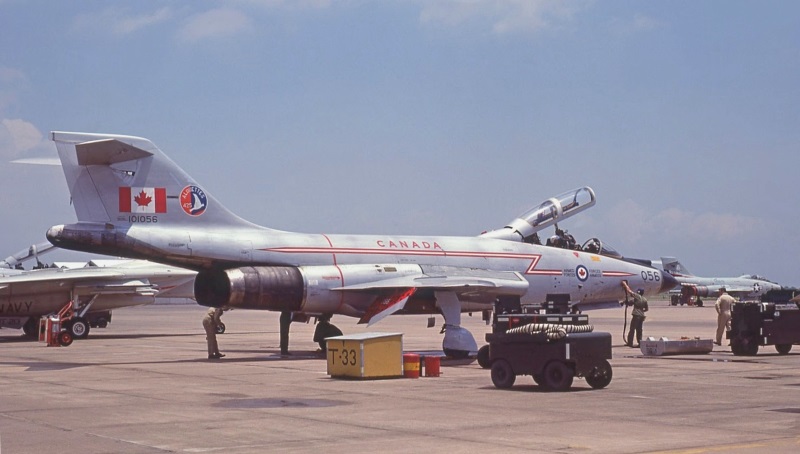
In 1970:1971, the 46 survivors of the initial batch were "traded in" for 56 improved F-101Bs and 10 F-101Fs under the PEACE WINGS programs. These were upgraded machines featuring the IRST, FCS, and other improvements obtained in the BOLD JOURNEY program. Canadian CF-101s were retained in service into the early 1980s, when they were replaced by the McDonnell Douglas CF/A-18A/B Hornet. That wasn't quite the end of the Voodoo in Canadian service, however, with two F-101Bs leased from the USAF in 1982:
The two aircraft were returned to the USAF in 1987.
BACK_TO_TOP* In early 1953, while the F-101A was in development, the Air Force asked McDonnell to design a photo-reconnaissance derivative of the type under the "Weapons System 105L (WS-105L)" program. It was fairly straightforward to modify the F-101A for the reconnaissance mission by eliminating the armament, adding a long nose with four film cameras -- forward oblique, left and right oblique, and vertical -- for low-level photography, plus two high-altitude vertical cameras behind the cockpit where the ammunition boxes used to be. The nose cameras were stowed on a pallet that could be electrically winched down for servicing.
This work led to the initial flight of the first of two "YRF-101A" evaluation reconnaissance machines on 10 May 1956. 35 production RF-101As were built, with the first going into operational service in May 1957. It was followed in production by the "RF-101C", with the reinforced airframe of the F-101C, with 166 built. Unlike the RF-101A, the RF-101C was wired to carry a centerline nuclear store.

The RF-101A/C set a number of long-distance speed records early in its service. It performed a series of reconnaissance missions over Cuba during and after the Missile Crisis of the fall of 1962. The RF-101C (though not the RF-101A) then went on to serve extensively over Southeast Asia from 1964. Although the RF-101A/C originally flew in natural metal colors, in the combat theater it quickly acquired more warlike standard colors of light gray underneath, with a green and tan disruptive camouflage pattern on top. It also gradually acquired defensive countermeasures systems.
The first RF-101C to be lost in action was shot down on 21 November 1964; a total of 31 were lost in combat (some sources give 33), along with six lost in accidents, up to the time the type was withdrawn from the war zone in 1970. It was replaced by the RF-4C Phantom.
___________________________________________________________________
MCDONNELL RF-101C VOODOO:
___________________________________________________________________
wingspan:
12.09 meters (39 feet 8 inches)
wing area:
34.19 sq_meters (368 sq_feet)
length:
21.11 meters (69 feet 3 inches)
height:
5.49 meters (18 feet)
empty weight:
11,615 kilograms (25,610 pounds)
MTO weight:
21,895 kilograms (48,270 pounds)
max speed at altitude:
1,800 KPH (1,220 MPH / 975 KT)
service ceiling:
15,850 meters (52,000 feet)
range with tanks:
3,860 kilometers (2,400 MI / 2,085 NMI)
___________________________________________________________________
Taiwan operated eight RF-101As passed on from the USAF in 1959, possibly with the Taiwanese acting as proxies for US intelligence, to perform reconnaissance overflights of mainland China. Two of these machines were apparently shot down. The RF-101A was completely out of service by 1970, with the RF-101C following in 1975.
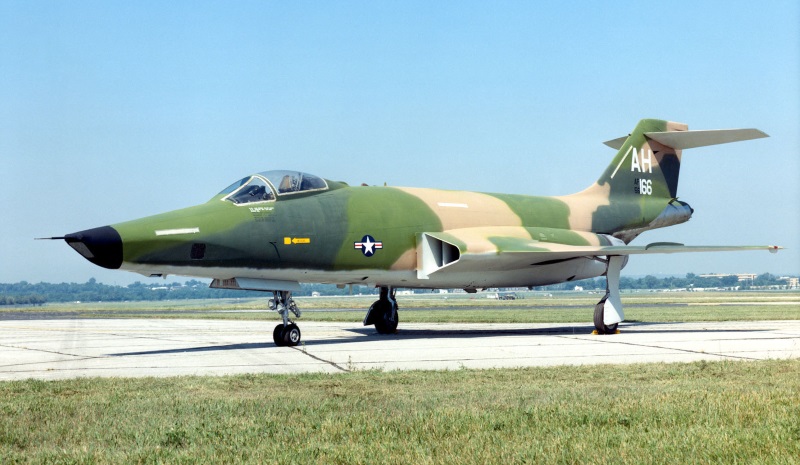
* As mentioned above, after the retirement of the F-101A/C, a number of those machines were converted by Lockheed to a reconnaissance configuration. There were 29 upgrades of F-101As to the "RF-101G" configuration and 31 upgrades of F-101Cs to the "RF-101H" configuration, with all these aircraft serving stateside with various ANG units. The upgrade was the same in both cases, primarily focused on the fit of a camera nose along the lines of that of the RF-101A/C, but noticeably shorter. The first RF-101Gs went into service in 1965, acquiring disruptive camouflage like those of combat-zone RF-101Cs. The RF-101G/Hs were all out of service by 1979.

Following the return of the initial batch of F-101Bs supplied to Canada, Ling-Temco-Vought modified 22 of them to a reconnaissance configuration, featuring a reconnaissance nose with left, vertical, and right film cameras plus forward-looking and downward-looking TV cameras; the back-seater had a TV display to observe the terrain below in real time. These machines were redesignated "RF-101B", given camouflage colors, and served with the Nevada ANG's 192nd Tactical Reconnaissance Squadron from 1971 to 1975, when they were replaced by the McDonnell RF-4C Phantom. The RF-101Bs were intended as a "low-cost" interim solution, but "creeping featurism" and the short service life made them a poor deal.
* The following list gives Voodoo variants and production:
* When I was growing up in Spokane, Washington, the ANG generally operated the F-89 and then the F-106 -- but I do recall seeing the F-101B flying around for a relatively brief period of time.
* Sources include:
Comments were also taken from an online document by aviation enthusiast Joe Baugher.
* Illustrations details:
* Revision history:
v1.0.0 / 01 jul 08 v1.0.1 / 01 sep 08 / Minor corrections. v1.0.2 / 01 aug 10 / Review & polish. v1.0.3 / 01 jul 12 / Review & polish. v1.0.4 / 01 jun 14 / Review & polish. v1.0.5 / 01 mar 16 / Review & polish. v1.0.6 / 01 apr 18 / Review & polish. v1.0.7 / 01 mar 19 / Review & polish. v1.0.8 / 01 jul 19 / Illustrations update. v1.0.9 / 01 may 21 / Review & polish. v1.1.0 / 01 mar 23 / Review & polish.BACK_TO_TOP
